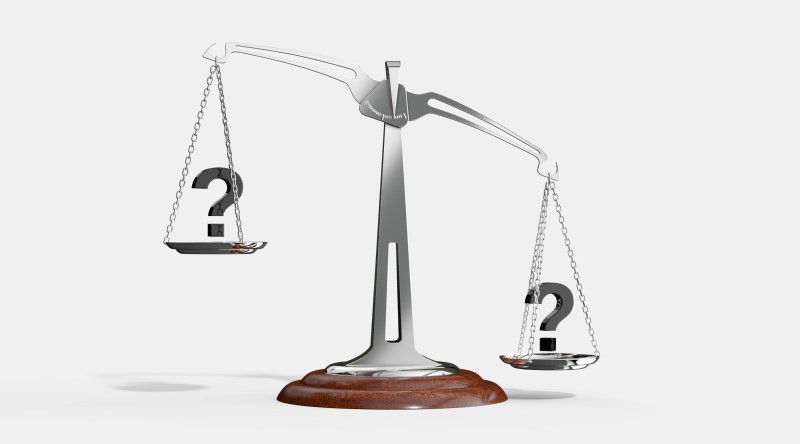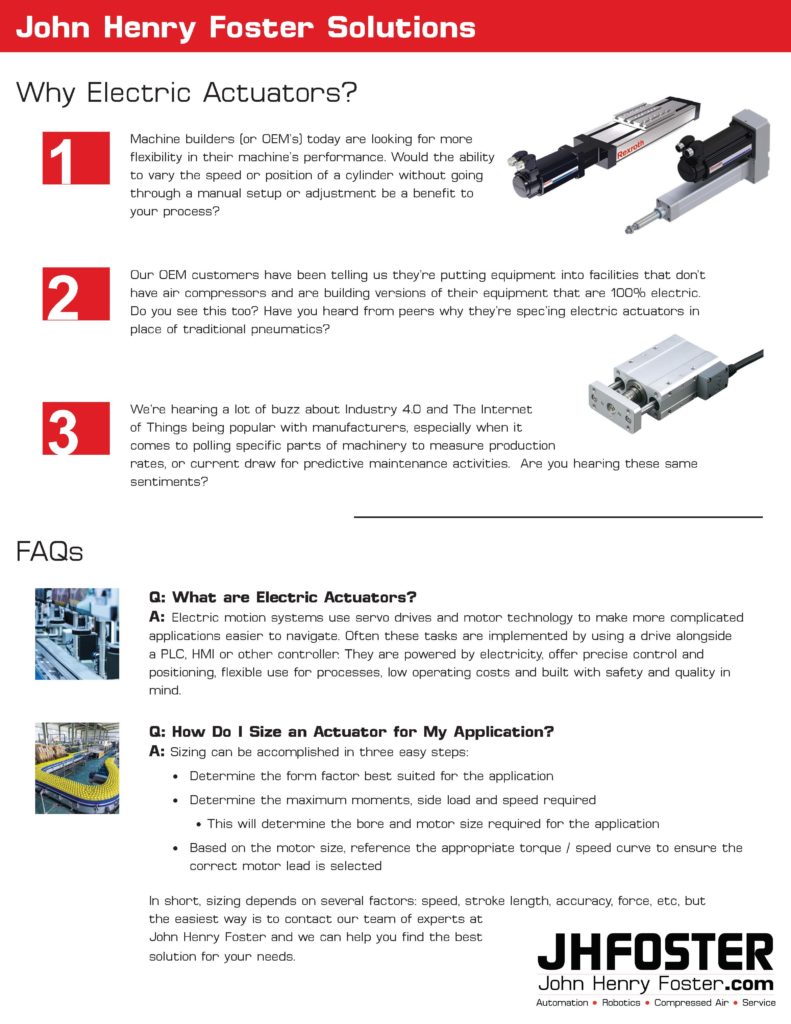How to Choose Between an Electric or Fluid-Powered Actuator
Actuators are used to control the motion of devices and machines, such as robots and automated equipment. High-quality actuators will move at the required speed and provide the appropriate level of force for the application, use as little power as possible and provide enough accuracy to suit the task. Actuators are available as electric or fluid powered, so it can be difficult to determine which is the best choice for an application. This article will discuss the advantages and disadvantages of each type and provide guidance for actuator selection.
What is an Actuator?
The main function of an actuator is to create motion and/or move a load. In most cases, if an automated machine, piece of equipment or robot moves, there’s a good chance an actuator plays a crucial role in that motion. Because actuators provide a reliable and efficient means of motion, they are used in many industrial applications including food and beverage processing, material handling, robotics and motion control.
Whether they are electric or fluid powered, most actuators use some type of prime mover in conjunction with a transmission to change rotatory motion to linear, or straight-line, motion. The main difference between the two types is in how they are powered, with electric versions relying on electrical power and fluid-power types using either fluid, gas or air to generate motion.

The Difference Between Electric and Fluid-Powered Actuators
Electric actuators consist of motors, linear guides and drive mechanisms and convert electrical energy into straight-line or push-pull motion. Electric actuators rely on an electric-powered motor to drive a mechanical transmission such as a ball screw, roller screw, worm gear, belt drive or rack and pinion, so they are able to perform at high or low speeds with excellent precision and efficiency.
Fluid-powered actuators may be pneumatic or hydraulically powered, meaning they rely on air, gas or fluid to generate motion. They usually feature a piston that moves along the inside of a hollow cylinder where air, gas or fluid is delivered via a pump to move the cylinder. As pressure increases, the cylinder moves along the axis of the piston to create linear force. As the fluid is supplied on the piston’s other side or by a spring-back force, the piston returns to its original position. Fluid-powered actuators are known for their reliability, ability to supply great forces and hold torque and force consistently.
The Pros and Cons of Electric Actuators
Because electric actuators rely on electrical power and not an intermediate fluid with mass, inertia, turbulence, compressibility and/or viscosity, they are able to provide superior efficiency and precise control of speed, position and force and the holding torque of their electric motors and mechanical transmissions prevent positional drifting. Many electric actuators offer continuous positional feedback, allowing them to handle more complex motions and repeat specific motions with reliability and accuracy.
In addition, electric actuators tend to be more energy efficient, smaller and quieter than their fluid-powered counterparts. Because electric actuators only consume current in the drive motor when it is required, they require little or no current when at rest or when holding a position. Electric actuators are more compact because they only require the motor and a small control cabinet for the drive, which can be located near the point of use.
Environmentally friendliness is another advantage of electric actuators as there are no hydraulic fluids involved, which can leak and create messy hazards in hydraulic systems. There is also no possibility of air leaks from the system, which can create inefficiencies in pneumatically driven actuators.
However, there are disadvantages, as well. Electric actuators tend to be more complex because of their mechanical transmission, feedback systems and necessary wiring. These factors also make electric actuators more expensive. Additionally, because they use electricity, electric actuators should not be used in areas where concerns of sparks, fires or explosions exist or in very wet, dirty or dusty environments unless properly rated and installed.

The Pros and Cons of Fluid-Powered Actuators
Because fluid-powered actuators use no electricity, they can be implemented in environments that are dusty and dirty, as well as those that are wet or at risk for fire or explosion. If they contain electrically controlled valves, these may be placed a safe distance away. Another key advantage of fluid-powered actuators is that they typically provide higher forces than electric actuators. Additionally, if a pneumatically driven actuator is selected, most industrial facilities already have a functioning air compression system in place. Finally, because of their simplicity, fluid-powered actuators are less costly than electric actuators.
One of the biggest drawbacks to using a fluid-powered actuator is that they are less environmentally friendly as they rely on compressed air, which can be inefficient, or hydraulic fluids, which often leak, creating an environmental hazard, as well as additional costs to clean up leaks and replace lost fluids. And, while fluid-powered actuators are capable of applying strong forces because of their pressurized power, this also makes them less precise, as fluid and air are more difficult to control.
Typical Applications
With a basic understanding of the strengths and weaknesses of electric and fluid-powered actuators, it is easy to see why each may be selected for a particular type of application. For example, electric actuators are commonly found in automation, motion control and robotic applications that require a controlled, precise and repeatable linear movement to a particular position. They may also be the technology of choice in applications that demand a smaller and/or quieter means of linear motion, as well as those where contamination from air or fluid leaks would pose a concern to the environment or the product being produced.
Fluid-powered actuators tend to be used in applications that require a strong force and/or holding torque, but do not require exacting precision or repeatability. They are also the choice in applications that may be wet, dirty or fire or explosion hazards. And, fluid-powered actuators are typically selected when budget is a concern.
Actuator Selection
There is no one-size-fits-all answer when it comes to choosing between an electric or fluid-powered actuator. Rather it will depend upon the specific requirements of the application, as well as the location and the budget. However, when selecting any type of actuator, there are some practical guidelines to help ensure that the selected actuator will meet the needs of the application. Important considerations include:
- Type of motion: Does the application require simple linear motion or will additional and more complex motions be needed. If the latter, an electric actuator may be a better choice.
- Energy input: If electric current and wiring are not feasible, a fluid-powered actuator will be more suitable as there is no need for a high-voltage input.
- Precision: Often smaller, more detailed and delicate jobs require the greater accuracy provided by an electric actuator, while heavy-duty machinery does not require precise control or accuracy, so a fluid-powered version may be the smarter, more economical choice.
- Force: The amount of force will vary by application, so determining the required force will be a major deciding factor during the selection process. Typically, fluid-powered actuators are capable of applying stronger forces, which is why they are often selected for construction and heavy-duty industrial equipment applications.
- Stroke length: Stroke length is another important consideration when selecting an actuator because space for actuator movement may be limited in any application, but especially in small equipment. Knowing how much room there is for movement in an application and ensuring that the actuator’s stroke length is accommodated will ensure it fits in the given space.
- Speed: Speed is a significant factor because actuators that require more force are typically slower than those that generate less force. Electric actuators tend to provide faster speeds than air-powered types as air- and fluid-controlled technologies can be slower to respond due to turbulence and other factors.
Understanding the requirements of the application will help ensure that the selected actuator will provide the motion, accuracy, speed and force needed for the application, as well as one that suits the location and budget. For more information on actuator selection, please contact a representative at JHFOSTER.
